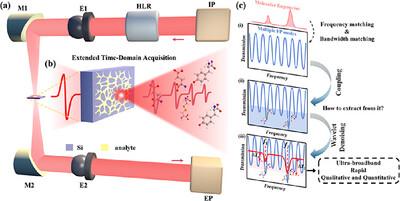基于非图像化介质晶圆的超宽带、快速、痕量太赫兹指纹检测
IF 10
1区 物理与天体物理
Q1 OPTICS
引用次数: 0
摘要
增强光与物质之间的相互作用,特别是在太赫兹波段,是实现超宽带痕量分子指纹检测的关键。本文提出了一种具有等间隔和均匀强度的多重法布里-帕姆罗模式的有效方案,以实现分子指纹的共振相互作用增强,同时具有期待已久的精度和灵活性。该技术在整个光谱范围内构建均匀的共振探针,通过频率选择性振幅衰减揭示分子耦合效应,实现L -酪氨酸的定性和定量检测,检测限为0.11µg mm−2。这是定量太赫兹痕迹指纹检测的首次实验成果,具有实现超宽带和高效率的双重能力。值得注意的是,该技术可以使用小波去噪算法直接识别传输的多个法布里-帕姆罗模式的分子吸收特征,从而消除了繁琐的数据后处理和冗余的测试程序。这一进步预示着太赫兹指纹光谱的一个新的,可访问的时代。本文章由计算机程序翻译,如有差异,请以英文原文为准。

Ultra‐Broadband, Rapid, and Trace Terahertz Fingerprint Detection via Resonance Interaction Enhancement with an Unpatterned Dielectric Wafer
Enhancing the interaction between light and matter, especially at the terahertz band, is pivotal for achieving ultra‐broadband trace molecular fingerprint detection. Here, an efficient scheme featuring multiple Fabry–Pérot modes with equal intervals and uniform intensity is presented to implement a resonance interaction enhancement of molecular fingerprints with long‐awaited precision and flexibility. This technique constructs uniform resonant probes across the entire spectral range to reveal molecular coupling effects via frequency‐selective amplitude attenuation, enabling both qualitative and quantitative detection of L‐tyrosine with a detection limit of 0.11 µg mm−2 . This is an inaugural experimental achievement of quantitative THz trace fingerprint detection with dual capabilities of achieving ultra‐broadband and high‐efficiency. Significantly, the technology enables direct identification of molecular absorption signatures from the transmitted multiple Fabry–Pérot modes using wavelet denoising algorithms, eliminating cumbersome data postprocessing and redundant testing procedures. This advancement heralds a new, accessible era in terahertz fingerprint spectroscopy.
求助全文
通过发布文献求助,成功后即可免费获取论文全文。
去求助
来源期刊
CiteScore
14.20
自引率
5.50%
发文量
314
审稿时长
2 months
期刊介绍:
Laser & Photonics Reviews is a reputable journal that publishes high-quality Reviews, original Research Articles, and Perspectives in the field of photonics and optics. It covers both theoretical and experimental aspects, including recent groundbreaking research, specific advancements, and innovative applications.
As evidence of its impact and recognition, Laser & Photonics Reviews boasts a remarkable 2022 Impact Factor of 11.0, according to the Journal Citation Reports from Clarivate Analytics (2023). Moreover, it holds impressive rankings in the InCites Journal Citation Reports: in 2021, it was ranked 6th out of 101 in the field of Optics, 15th out of 161 in Applied Physics, and 12th out of 69 in Condensed Matter Physics.
The journal uses the ISSN numbers 1863-8880 for print and 1863-8899 for online publications.

 求助内容:
求助内容: 应助结果提醒方式:
应助结果提醒方式:


